Functional training focuses on exercises that improve coordination, balance, and strength, enhancing real-world physical performance. It is designed to prepare individuals for daily activities and athletic demands effectively.
1.1 What is Functional Training?
Functional training involves exercises that mimic real-life movements, focusing on improving mobility, strength, and coordination. It prepares individuals for everyday tasks and athletic activities by targeting multiple muscle groups and enhancing overall physical efficiency.
1.2 Importance of Functional Training in Everyday Life
Functional training enhances physical performance by improving muscle strength, coordination, and balance. It prepares individuals for daily activities, reduces injury risk, and boosts overall efficiency, making it beneficial for everyone from sedentary individuals to athletes.
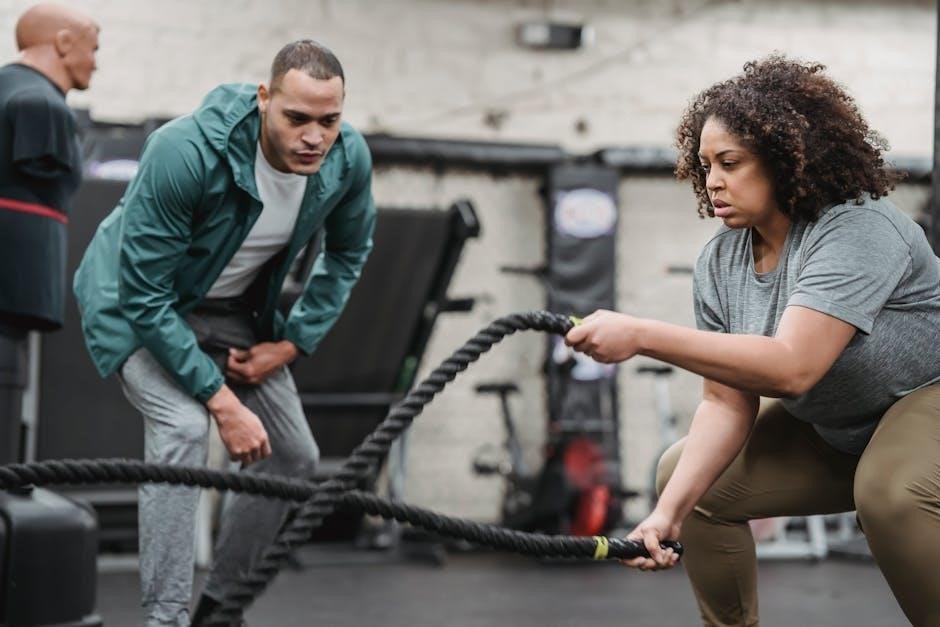
Benefits of a Functional Training Program
Functional training enhances strength, mobility, and coordination, improving daily activities and sports performance. It boosts metabolism and aids in weight management, promoting overall fitness.
2.1 Improved Mobility and Flexibility
Functional training incorporates dynamic stretches and movement exercises, enhancing joint mobility and muscle flexibility. These exercises mimic real-life motions, improving range of motion and reducing stiffness, making daily activities easier and reducing injury risk.
2.2 Enhanced Strength and Stability
Functional training strengthens core muscles and improves stability through compound movements like squats and lunges. These exercises enhance overall muscular endurance, boosting posture, balance, and athletic performance, while preparing the body for daily tasks and physical challenges.
2.3 Better Coordination and Balance
Functional training enhances coordination through dynamic exercises like single-leg stands and balance drills. These movements improve proprioception and overall stability, reducing injury risk and boosting athletic performance. Better balance also aids in executing daily tasks with precision and confidence, ensuring seamless physical responses in various situations.
2.4 Weight Management and Caloric Burn
Functional training is highly effective for weight management, as it combines compound movements and HIIT to maximize caloric burn. These workouts boost metabolism, helping the body burn calories even post-exercise, while building lean muscle to support long-term weight control and overall health.

Designing a Functional Training Program
Designing a functional training program involves setting clear goals, understanding exercise progressions, and incorporating variety to ensure comprehensive fitness development and real-world application of strength and mobility skills.
3.1 Setting Clear Fitness Goals
Setting clear fitness goals is essential for a functional training program. Goals should be specific, measurable, and achievable, focusing on improving strength, mobility, and overall performance. This helps in creating a structured plan tailored to individual needs and ensures steady progress over time.
3.2 Understanding Exercise Progressions
Exercise progressions involve gradually increasing intensity or complexity to improve strength and mobility. Structured progressions ensure continuous improvement, tailored to individual fitness levels. This approach prevents plateaus and enhances overall physical performance, making workouts more effective and engaging over time.
3.3 Incorporating Variety in Workouts
Variety in workouts keeps training engaging and prevents plateaus. By mixing compound movements, isolation exercises, and mobility drills, individuals can target different muscle groups and improve overall functional fitness. This diversity ensures well-rounded development and maintains motivation throughout the training program.

Safety and Injury Prevention
Ensuring safety is crucial in functional training. Proper warm-ups, technique, and injury prevention strategies are essential to avoid harm and maintain effective, injury-free workouts consistently.
4.1 Warm-Up and Cool-Down Routines
A proper warm-up prepares the body for exercise by increasing heart rate and flexibility, while a cool-down aids in recovery. Both routines are essential for preventing injuries and enhancing overall performance in functional training programs.
4.2 Proper Form and Technique
Maintaining proper form and technique is crucial in functional training to maximize efficiency and minimize injury risk. Focus on controlled movements, core engagement, and alignment to ensure exercises are performed effectively and safely, promoting optimal results and longevity in training.
4.3 Injury Prevention Strategies
Injury prevention in functional training involves dynamic stretching, foam rolling, and proper warm-ups. Incorporating high-intensity interval training (HIIT) and progressive overload safely can enhance performance. Listening to your body, managing training loads, and ensuring adequate rest are key to maintaining long-term injury-free participation in functional training programs.

Nutrition and Recovery
Nutrition and recovery are crucial for optimizing functional training outcomes. A balanced diet rich in macronutrients, proper hydration, and meal timing supports muscle repair and energy replenishment. Adequate rest, sleep, and stress management enhance recovery, while supplements like protein and creatine can further boost performance and muscle growth.
5.1 Role of Nutrition in Functional Training
A well-balanced diet is essential for functional training, providing the energy and nutrients needed for optimal performance. High-protein intake supports muscle repair, while complex carbs and healthy fats fuel workouts. Proper hydration and meal timing further enhance recovery and overall physical adaptation to training demands.
5.2 Importance of Rest and Recovery
Rest and recovery are crucial for muscle repair and growth, reducing muscle soreness, and improving overall performance. Adequate sleep and recovery allow the body to adapt to the demands of functional training, preventing overtraining and enhancing long-term progress and physical resilience.
5.3 Supplements for Enhanced Performance
Supplements like protein powder, BCAAs, and creatine can enhance performance by supporting muscle recovery, reducing soreness, and boosting energy levels. These additions, when paired with a well-structured functional training program, help optimize results and improve overall athletic performance and muscle endurance.
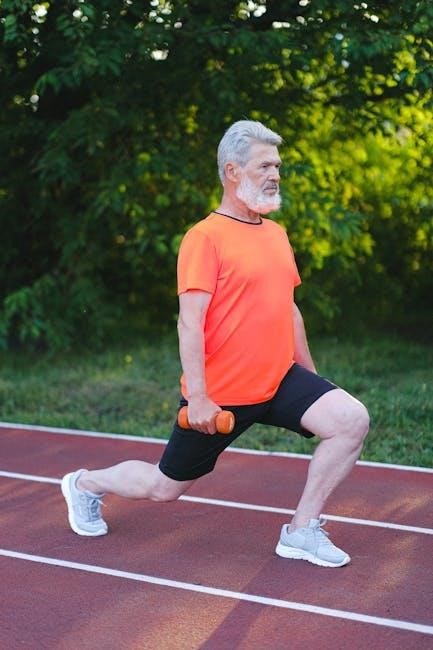
Types of Functional Exercises
Functional exercises include compound movements, isolation exercises, and mobility drills. These exercises target multiple muscle groups, improving strength, flexibility, and coordination, while mimicking real-life movements for practical fitness benefits.
6.1 Compound Movements
Compound movements, like squats and deadlifts, engage multiple muscle groups simultaneously. They enhance strength and coordination, closely mimicking real-life activities, making them a cornerstone of functional training programs. These exercises improve overall fitness and functional efficiency effectively, preparing the body for daily tasks and physical challenges.
6.2 Isolation Exercises
Isolation exercises target specific muscle groups, such as bicep curls or leg extensions, to enhance individual muscle growth and strength. While less dynamic than compound movements, they help correct imbalances and improve recovery, making them a valuable component of functional training programs for targeted muscle development.
6.3 Mobility and Flexibility Exercises
Mobility and flexibility exercises, such as dynamic stretching and foam rolling, enhance range of motion and reduce muscle tension. These movements improve joint health, prevent injuries, and promote better posture, making them essential for long-term functional fitness and overall physical well-being.
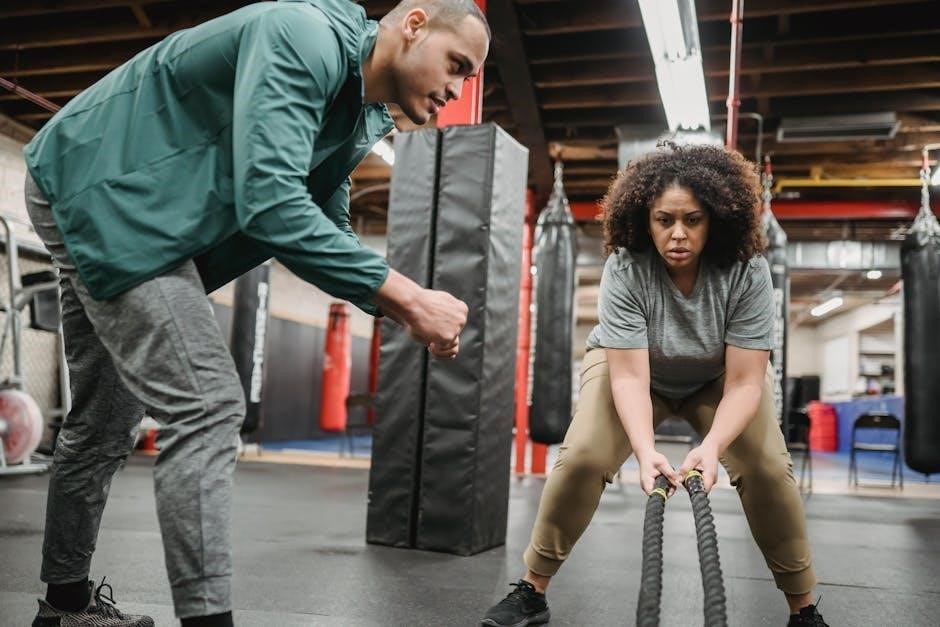
Sample Functional Training Workout Plan
A structured 4-day plan focusing on full-body circuits, upper body strength, lower body power, and core mobility. Each day includes dynamic exercises to enhance functionality and overall fitness.
7.1 Day 1: Full-Body Circuit
Begin with a dynamic warm-up. Perform 3 rounds of exercises like squats, push-ups, lunges, and planks. Include kettlebell swings, deadlifts, and burpees for a full-body challenge. Rest for 60-90 seconds between rounds. This circuit enhances strength, endurance, and functional mobility effectively in 45 minutes, promoting overall fitness.
7.2 Day 2: Upper Body Focus
Target chest, shoulders, and arms with push-ups, dumbbell presses, and pull-ups. Include variations like incline or decline presses for depth. Perform 3-4 sets of 8-12 reps. Add dynamic movements like medicine ball throws to enhance functional strength and coordination, ensuring a well-rounded upper body workout in 45 minutes.
7.3 Day 3: Lower Body Focus
Focus on squats, deadlifts, and lunges to build leg and glute strength. Include step-ups and plyometric exercises like box jumps for explosiveness. Perform 3-4 sets of 8-12 reps. Add core-stabilizing movements like side plank leg lifts. This 45-minute workout enhances lower body power and functional mobility, ensuring proper form and safety.
7.4 Day 4: Core and Mobility
Focus on core stability with planks, Russian twists, and leg raises. Incorporate mobility exercises like cat-cow stretches, hip circles, and calf raises. Perform 3 sets of 10-15 reps. Conclude with dynamic stretching to enhance flexibility and range of motion, ensuring proper form and muscle engagement for optimal results.

Advanced Training Strategies
Advanced strategies include periodization, HIIT, and progressive overload to optimize functional training. These methods enhance performance, improve adaptability, and ensure continuous progress in strength and mobility over time.
8.1 Periodization of Training
Periodization involves structuring training into phases with specific goals. This approach prevents plateaus, enhances recovery, and improves performance. It alternates intensity and volume to optimize results, ensuring long-term progress and adaptability in functional training programs.
8.2 Incorporating High-Intensity Interval Training (HIIT)
HIIT involves short bursts of intense exercise followed by brief recovery periods. It boosts cardiovascular fitness, burns calories efficiently, and enhances metabolic rate. Incorporating HIIT into functional training programs accelerates fat loss, improves muscular endurance, and increases overall physical performance in a time-efficient manner.
8.3 Progressive Overload in Functional Training
Progressive overload involves gradually increasing exercise intensity by adding weight, reps, or resistance. This approach enhances strength, muscle mass, and functional capacity. Applied to functional training, it ensures continuous improvement and prevents plateaus by challenging the body progressively, promoting adaptation and improved performance in real-life movements.
Mobility and Flexibility Training
Mobility and flexibility training enhances movement efficiency, reduces injury risk, and improves overall physical performance by targeting joint health and muscle elasticity through dynamic and static exercises.
9.1 Dynamic Stretching Exercises
Dynamic stretching involves active movements that mimic real-life actions, enhancing flexibility and range of motion. Examples include arm circles, leg swings, and torso twists, which prepare muscles for physical activity and improve joint mobility for functional training.
9.2 Foam Rolling and Self-Myofascial Release
Foam rolling and self-myofascial release target muscle tension and improve circulation. Techniques involve rolling muscles to release knots, reducing soreness and enhancing recovery. Regular practice supports joint mobility and overall muscle function, making it a key component of functional training routines.
9.3 Yoga for Functional Mobility
Yoga enhances functional mobility by improving flexibility, balance, and strength. Through targeted poses and breathing techniques, it supports joint health and muscle alignment, reducing injury risk and boosting overall physical performance, making it a valuable addition to functional training programs.
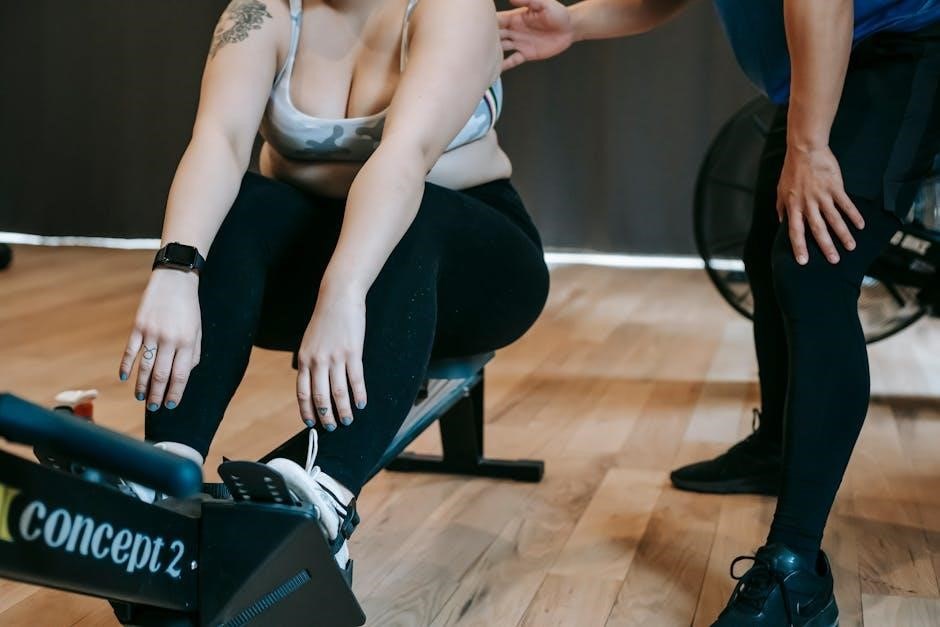
Evaluating Progress
Evaluating progress involves tracking workout metrics, assessing functional improvements, and adjusting the training program to optimize results and ensure continuous development in strength, mobility, and overall performance.
10.1 Tracking Workout Metrics
Tracking workout metrics involves monitoring repetitions, sets, weight lifted, and exercise consistency. Using logs or digital tools, individuals can measure progress, identify patterns, and adjust routines for optimal improvement in strength, endurance, and functional performance over time.
10.2 Assessing Functional Improvements
Assessing functional improvements involves evaluating how well exercises translate to real-world activities. Metrics like increased mobility, enhanced strength, and better coordination are measured. Progress is tracked through performance tests, providing insights into how functional training positively impacts daily life and athletic performance over time.
10.3 Adjusting the Training Program
Adjusting the training program involves modifying exercises, intensity, or volume based on progress and goals. Periodization and progressive overload are key strategies to ensure continued improvement and prevent plateaus, keeping the program challenging and aligned with the individual’s evolving fitness needs and objectives.

Long-Term Adherence
Staying motivated and avoiding plateaus is crucial for long-term adherence. Continuous learning and program adjustments keep the training engaging and effective, ensuring sustained commitment and progress over time.
11.1 Staying Motivated
Staying motivated requires setting personal goals and celebrating progress. Incorporating variety in workouts and tracking improvements helps maintain engagement. Surrounding yourself with a supportive community or accountability partner also fosters long-term commitment to functional training programs.
11.2 Avoiding Plateaus
Avoiding plateaus involves varying exercises, intensity, and incorporating new challenges. Periodization, progressive overload, and HIIT can refresh routines. Tracking progress and setting new goals ensures continued improvement, keeping workouts engaging and effective for long-term success in functional training programs.
11.3 Continuous Learning and Improvement
Continuous learning involves staying updated on new techniques, seeking expert guidance, and adapting routines. Incorporating feedback and reflecting on progress fosters improvement. Embracing a growth mindset and exploring diverse exercises ensures long-term development in functional training, supported by a community and regular self-assessment.
Functional training is a highly effective method for improving overall fitness and daily functionality. Its holistic approach ensures lasting benefits, making it a valuable investment for long-term health and performance.
12.1 Summary of Key Points
Functional training is a holistic approach that enhances strength, mobility, and coordination, benefiting daily life and athletic performance. Its adaptability to all fitness levels makes it a valuable tool for improving overall health and physical functionality, ensuring long-term wellness and performance capabilities.
12.2 Final Thoughts on Functional Training
Functional training is a highly effective method for improving strength, mobility, and overall physical performance. Its adaptability to various fitness levels makes it a sustainable choice for long-term health. Consistent effort and proper guidance ensure lasting benefits, making it a cornerstone of a well-rounded fitness regimen for individuals of all backgrounds.
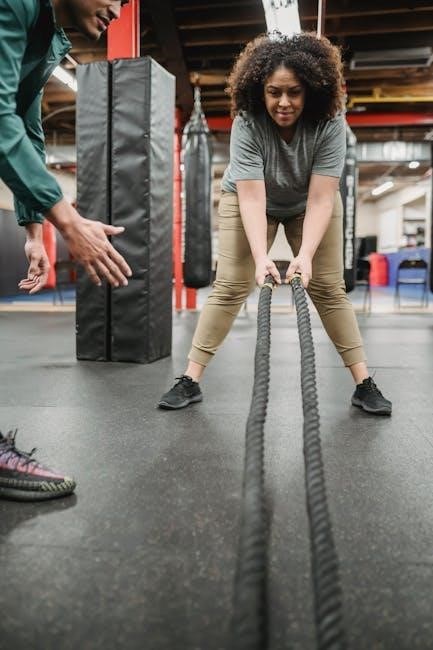



About the author